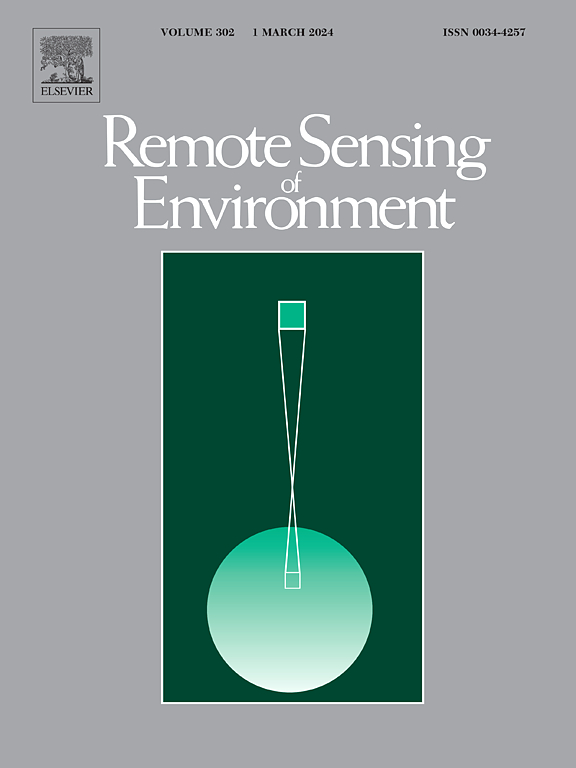Changes in GEDI-based measures of forest structure after large California wildfires relative to pre-fire conditions
IF 11.1
1区 地球科学
Q1 ENVIRONMENTAL SCIENCES
引用次数: 0
Abstract
Forest productivity, biodiversity, and ecosystem services in California and the Western United States are closely tied to fire. However, fire regimes are shifting toward larger, more severe fires driven by factors such as high fuel loads and increased temperature and aridity. While multispectral satellite (e.g., Landsat) burn indices provide valuable insights into fire severity, they primarily capture top-of-canopy greenness, missing important sub-canopy changes in vegetation structure and residual fuels. The Global Ecosystem Dynamics Investigation (GEDI) spaceborne lidar mission provides current and consistent, near-global 3D forest structure measurements, enabling detailed assessment of forest changes from disturbances such as wildfire. This study utilized near-coincident, bitemporal pre- and post-fire GEDI on-orbit measurements to analyze structural changes across thirty-four large California wildfires (2019 to 2021). We examined twelve GEDI-based forest structure metrics representing a variety of 3D fuels properties, including forest height, low-stature fuels, biomass, canopy heterogeneity, volume and cover. Our broad goals were to: 1) assess GEDI's ability to detect structural changes in burned areas relative to control areas; and 2) in burned areas, explore relationships between forest structural change and factors such as pre-fire fuel loads, Landsat-based differenced Normalized Burn Ratio (dNBR), topographic slope, wind speed, vapor pressure deficit, evapotranspiration, and time since fire. Results showed significant structural loss in all GEDI structural metrics for burned areas relative to nearby controls. Pre-fire fuel loads measured by GEDI metrics were the strongest predictors of post-fire structural change, with linear models explaining an average of 46 % of variance. Model slopes showed increasing levels of pre-fire fuels were associated with large, significant post-fire decreases in canopy structure – that is, more fuels lead to higher wildfire severity, particularly for conifer forests of the Klamath, Cascades and Sierra Nevada ecoregions. One metric, measuring the proportion of waveform energy below 10 m height, increased significantly after fire in mixed and conifer forests due to canopy opening, which enhanced lidar penetration toward the ground. In contrast, the widely-used dNBR burn severity index was less correlated with GEDI-based forest structural change than pre-fire fuels, particularly in sub-canopy fuels, with models explaining no more than 32 % of the variance (average 19 %). GEDI overcomes key limitations of airborne lidar, including high cost, limited extent, and data latency, enabling scalable and timely assessments of wildfire impacts needed to manage fuels and track forest resilience and recovery. Further, GEDI metrics are physically-based and ecologically interpretable, providing complimentary information to multispectral burn severity indices.
加州大火后相对于火灾前条件的基于gedi的森林结构测量的变化
加州和美国西部的森林生产力、生物多样性和生态系统服务与火灾密切相关。然而,在高燃料负荷、温度升高和干旱等因素的驱动下,火灾正在向更大、更严重的火灾转变。虽然多光谱卫星(例如Landsat)燃烧指数提供了对火灾严重程度的宝贵见解,但它们主要捕获冠层顶部的绿色,而忽略了植被结构和剩余燃料的重要亚冠层变化。全球生态系统动力学调查(GEDI)星载激光雷达任务提供当前的、一致的、近全球的三维森林结构测量,能够详细评估野火等干扰对森林变化的影响。本研究利用近同时、火灾前后双时间的GEDI在轨测量数据,分析了加州34起大型野火(2019年至2021年)的结构变化。我们研究了12个基于gedi的森林结构指标,这些指标代表了各种3D燃料特性,包括森林高度、低高度燃料、生物量、冠层异质性、体积和覆盖度。我们的主要目标是:1)评估GEDI检测烧伤区域相对于控制区域结构变化的能力;2)探索火灾前燃料负荷、基于landsat的差异归一化燃烧比(dNBR)、地形坡度、风速、蒸汽压亏缺、蒸散量和火灾后时间等因素与森林结构变化的关系。结果显示,相对于附近的对照组,烧伤区域的所有GEDI结构指标都有明显的结构损失。GEDI指标测量的火灾前燃料负荷是火灾后结构变化的最强预测指标,线性模型平均解释46%的方差。模型坡度显示,火灾前燃料水平的增加与火灾后冠层结构的大幅显著减少有关,也就是说,更多的燃料导致更高的野火严重程度,特别是对于克拉马斯、喀斯喀特和内华达山脉生态区的针叶林。在混交林和针叶林中,测量10 m高度以下波形能量比例的指标在火灾后由于冠层开放而显著增加,这增强了激光雷达对地面的穿透。相比之下,与火灾前燃料相比,广泛使用的dNBR燃烧严重程度指数与基于gedi的森林结构变化的相关性较低,特别是在亚冠层燃料中,模型解释的差异不超过32%(平均为19%)。GEDI克服了机载激光雷达的主要局限性,包括高成本、有限范围和数据延迟,能够对野火影响进行可扩展和及时的评估,从而管理燃料并跟踪森林的恢复能力和恢复能力。此外,GEDI指标是基于物理和生态解释的,为多光谱烧伤严重程度指数提供了补充信息。
本文章由计算机程序翻译,如有差异,请以英文原文为准。
求助全文
约1分钟内获得全文
求助全文
来源期刊

Remote Sensing of Environment
环境科学-成像科学与照相技术
CiteScore
25.10
自引率
8.90%
发文量
455
审稿时长
53 days
期刊介绍:
Remote Sensing of Environment (RSE) serves the Earth observation community by disseminating results on the theory, science, applications, and technology that contribute to advancing the field of remote sensing. With a thoroughly interdisciplinary approach, RSE encompasses terrestrial, oceanic, and atmospheric sensing.
The journal emphasizes biophysical and quantitative approaches to remote sensing at local to global scales, covering a diverse range of applications and techniques.
RSE serves as a vital platform for the exchange of knowledge and advancements in the dynamic field of remote sensing.
 求助内容:
求助内容: 应助结果提醒方式:
应助结果提醒方式:


